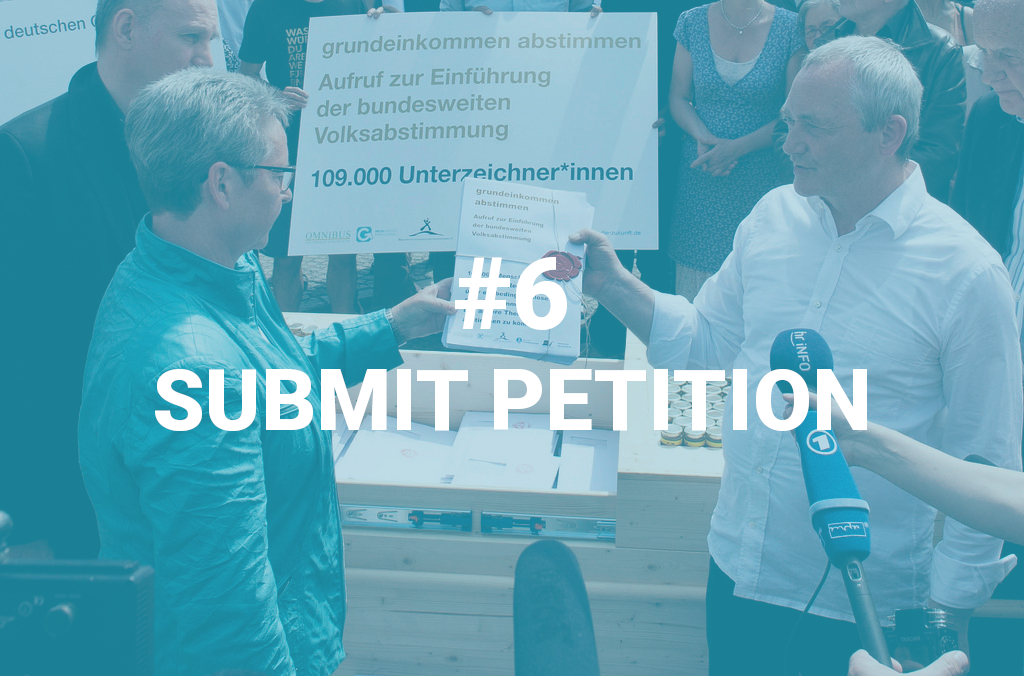
հանձնում
Ձեր միջնորդագրի հանձնումը պետք է լինի լրատվամիջոցների համար արդյունավետ միջոցառում։ Դուք կարող եք օգտագործել այս հնարավորությունը հանրության ուշադրությունը կրկին ձեր մտահոգություններին հրավիրելու և այդպիսով որոշում կայացնողների վրա ճնշում գործադրելու համար։
նշանակել հանդիպում:
Խնդրում ենք հանձնման ամսաթիվը նախապես հարցնել, քանի որ քաղաքական գործիչների գրաֆիկները սովորաբար լիքն են։ Այսպիսով, խնդրում ենք հաշվի առնել մի քանի շաբաթ առաջվա ժամանակը։
Եթե հասցեատերը մերժում է նշանակումը, առաջարկեք նորը և, անհրաժեշտության դեպքում, կապվեք տեղակալների, խոսնակների կամ բաժնի ղեկավարների հետ։ Մինչև հանձնումը ձախողվի, ավելի լավ է գտնել մեկ այլ հարմար անձ։ Նախորդ գլխում մենք նաև բացատրեցինք, թե ինչպես կարող եք մեծացնել ճնշումը, որպեսզի հանրային դեմքերի հետ անձնական փոխադարձ փոխանցում տեղի ունենա։
Անձնական հանձնում
Դիմում ստացած անձը կհանդիպի ձեր պահանջներին։ Պատրաստվեք հանձնմանը կամ ձեր պահանջների քննարկմանը։ Կիսվեք ձեր անձնական պատմությամբ և հրավիրեք ձեր աջակիցներին միանալ ձեզ հանձնման արարողությանը։
Հրավիրեք մամուլին:
Մամուլի համար քաղաքական գործիչների և հասարակական գործիչների հետ հանդիպումները հետաքրքրություն են ներկայացնում, հատկապես, երբ նրանք բախվում են մարտահրավերային կամ զգայուն հարցերի։ Հրավիրեք մամուլին և լուսանկարիչներին մի քանի օր առաջ և համառոտ նկարագրեք, թե ինչ է տեղի ունենալու և արդյոք կլինեն լուսանկարվելու հնարավորություններ։ Դրա համար կարող եք օգտագործել մամուլի հաղորդագրություն։ Խնդրում եմ կցել խնդրագրի հղումը։
Կազմակերպեք մամուլի համար հանձնման գործընթացը:
Եթե կարողանաք լավ լուսանկարվելու հնարավորություն ապահովել, մամուլն ավելի շատ կհետաքրքրվի ձեր պատմությամբ և ձեր գործով։ Հեռուստաընկերությունները օպերատորական խմբեր չեն ուղարկում, եթե տեսնելու ոչինչ չկա։ Ահա մի քանի առաջարկներ։:
- Տպեք ստորագրությունների ցուցակները և հանձնեք դրանք հաստ «գրքի» տեսքով կամ նույնիսկ մի քանի տուփերի մեջ, որոնք տպավորիչ կերպով կույտ-կուտակվեն։
- Տպեք խնդրագրի խնդրանքը, ներառյալ խնդրագրի պատկերը և ստորագրությունների քանակը, որպես պաստառ և բարձրացրեք այն։ Դուք կարող եք ներբեռնել ձեր խնդրագրի համար ավտոմատ կերպով ստեղծված հանձնման պաստառ։
- Հրավիրեք աջակիցներին և միասին փոխանցեք մտահոգությունները։
- Զրույց ստացողի հետ։
- Ոչ պարտադիր, բայց հատկապես արդյունավետ՝ հանձնման-հանձնման բեմադրությունը և գործողություններ:
Օրինակ՝ պաստառով դուք միշտ ուշադրություն եք գրավում և սիրված թեմա եք մամուլի լուսանկարիչների համար։ Ձեր խնդրագրի կառավարման բաժնում (մուտք գործելուց հետո նարնջագույն շերտը), «Ներբեռնել» ներդիրի տակ, դուք կգտնեք տպելու համար ստորագրությունների ցանկերը, ինչպես նաև ավտոմատ կերպով ստեղծված պաստառ՝ տարածելու համար: Իհարկե, կարող եք նաև ստեղծել ձեր սեփականը: Հատկապես մեծ ֆորմատի պաստառները գրավում են ուշադրությունը և մամուլի համար լուսանկարչական հայտնի թեմա են։ Դուք կարող եք օգտագործել openPetition լոգոն այս նպատակով։: Սպիտակ ֆոնով լոգո , Լոգո առանց ֆոնի գույնի
Գրեք մամուլի հաղորդագրություն
Հաղորդեք հանձնման, խնդրագրի պահանջների, աջակիցների թվի և ձեր հաջորդ քայլերի մասին։ Մամուլի հաղորդագրությունը պետք է խմբագրություններ հասնի ամենաուշը կեսօրից հետո, որպեսզի այն հրապարակվի հաջորդ օրը։ Համոզվեք, որ կոնտակտային անձին տրամադրեք հեռախոսահամար, որպեսզի կարողանան կապվել ձեզ հետ հարցումների համար և, հնարավոր է, նույնիսկ հարցազրույց տալ։ Խորհուրդներ Մամուլի հաղորդագրություն .
Ի՞նչ անել, եթե ոչ ոք չի ցանկանում ընդունել ձեր դիմումը։
Լավագույնս օգտվեք իրավիճակից։ Ընկերության ղեկավարները, որոնք հրաժարվում են հանդիպում նշանակել մարտահրավեր նետող միջնորդությունը հանձնելու համար, միայն այդ պատճառով են հետաքրքիր մամուլի համար։ Ամեն դեպքում հանձնում կատարեք։ Օրինակ՝ վարձակալեք սենյակ քաղաքապետարանում կամ նահանգային խորհրդարանում, կամ ընտրեք ներկայացուցչական վայր ընկերության գլխավոր գրասենյակի դիմաց։ Ներկայացրեք ստորագրությունները դատարկ աթոռին ուրիշի անունից. դա հստակ կդարձնի, որ ձեր խնդրանքը անտեսվում է և ճնշում կգործադրի որոշում կայացնողների վրա։ Հրավիրեք լրագրողներին և լուսանկարիչներին։
Տեղեկացրեք ձեր կողմնակիցներին
Տեղեկացրեք ձեր կողմնակիցներին, որ դուք ներկայացրել եք միջնորդագիրը և տեղեկացրեք, թե ինչ է կատարվելու հաջորդիվ։ Իրենց գործի համար ստորագրած մարդիկ ցանկանում են իմանալ, թե ինչ է պատահել խնդրագրին. վերջիվերջո, դա նաև իրենց խնդրագիրն է։ Գրեք բլոգի գրառում ձեր խնդրագրի էջում և ուղարկեք էլեկտրոնային նամակ՝ թարմացումներ ստանալու համար։ Համոզվեք, որ համապատասխանաբար փոխում եք ձեր միջնորդագրի կարգավիճակը։
Ներկայացրեք միջնորդություն
Խորհրդանշական հանձնումից բացի, քաղաքական մտահոգություն ունեցող միջնորդությունները նույնպես պետք է պաշտոնապես ներկայացվեն համապատասխան միջնորդությունների հանձնաժողովին։ Դուք կարող եք նաև դիմումներ ներկայացնել տեղական մակարդակով՝ նահանգային մակարդակով։ Այնուամենայնիվ, սովորաբար ավելի արդյունավետ է երկխոսություն փնտրել քաղաքապետերի և քաղաքային կամ մունիցիպալ խորհուրդների հետ։ Խնդրեք հայտարարություն և խորհրդանշական հանձնում:
Ինչպե՞ս և որտե՞ղ կարող եմ ներկայացնել իմ դիմումը։
Դուք սովորաբար կարող եք ձեր միջնորդությունը ներկայացնել փոստով կամ առցանց ձևաթղթի միջոցով։ Համոզվեք, որ նշել եք ձեր openPetition (կարճ հղումով) և ստորագրությունների քանակը։
ԵՄ-ում դիմումի իրավունքը
Հանրագրի իրավունքը ամրագրված է ԵՄ Հիմնարար իրավունքների խարտիայի 44-րդ հոդվածում։ Եվրոպական խորհրդարանին միջնորդություն կարող է ներկայացնել ԵՄ ցանկացած քաղաքացի և ԵՄ-ում հաստատված ցանկացած իրավաբանական կամ ֆիզիկական անձ։ Սակայն նախապայմանն այն է, որ դիմումի առարկան պետք է լինի ԵՄ իրավասության շրջանակներում, և դիմումատուները անմիջականորեն տուժեն դրանից։ Դիմումը կարող է պարունակել անհատական խնդրանք, բողոք կամ դիտարկում ԵՄ իրավունքի կիրառման վերաբերյալ։ Եվրոպական խորհրդարանին կարող է նաև խնդրել մեկնաբանություն տալ որևէ կոնկրետ հարցի վերաբերյալ։ Նման միջնորդությունները Եվրոպական խորհրդարանին հնարավորություն են տալիս արձագանքել Միության քաղաքացու իրավունքների խախտումներին անդամ պետության կամ ԵՄ հաստատության կողմից։
Եվրոպական խորհրդարանին ուղղված դիմումները կարող են ներկայացվել գրավոր՝ փոստով, Եվրոպական խորհրդարանի կայքում առցանց կամ էլեկտրոնային փոստով։ Եվրոպական խորհրդարանը տարեկան ստանում է մոտ 1000 խնդրագիր։
Մնացեք կապի մեջ!
Հանձնումից հետո շարունակեք աշխատել ձեր հարցումը կատարելու ուղղությամբ։ Մնացեք կապի մեջ ստացողների, մամուլի և ձեր աջակիցների հետ։ Հանձնման ընթացքում լուսանկարներ և տեսանյութեր արեք և տեղադրեք դրանք սոցիալական ցանցերում՝ ձեր նվիրվածությունը ցույց տալու և ձեր գործը հանրության ուշադրության կենտրոնում պահելու համար։
Խնդրագրերի բլոգում պարբերաբար գրառումներ անելով՝ դուք կարող եք ձեր խնդրագրի բոլոր կողմնակիցներին տեղեկացված պահել նորությունների մասին, հայտարարել միջոցառումների մասին, հաղորդել առաջընթացի մասին կամ կիսվել խնդրագրի հաջողությամբ։ Այս գործառույթը մնում է հասանելի մեկ տարի ժամկետով, նույնիսկ դիմումների լրացումից հետո։ Նաև անպայման թարմացրեք ձեր խնդրագրի կարգավիճակը, որպեսզի կողմնակիցները իմանան, թե երբ է այն ներկայացվել և, հնարավոր է, նույնիսկ արդյոք այն հաջողությամբ ընդունվել է։
Աջակցություն openPetition միջոցով: Մենք կաջակցենք ձեզ այս բոլոր քայլերում։ Կարևոր է, որ դուք մեզ տեղեկացված պահեք։ Եթե նկատենք, որ դուք խիստ նվիրված եք, ապա մենք նույնպես կնվիրվենք ձեզ։ Օրինակ, եթե մենք իմանանք նախատեսված հանձնման մասին, մենք կարող ենք ձեզ տեղեկացնել և, անհրաժեշտության դեպքում, տեղեկացնել դրա մասին մեր միջոցով։